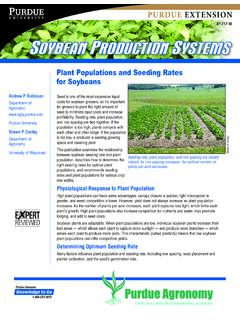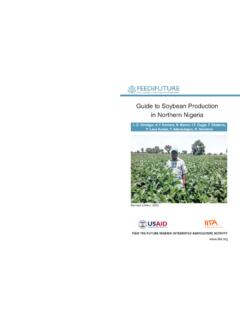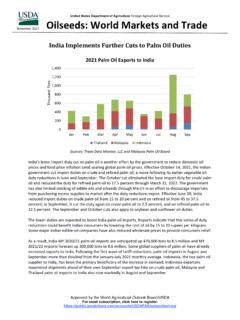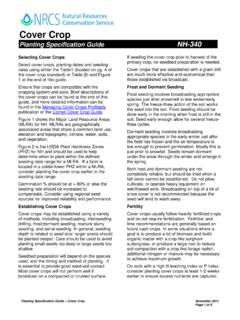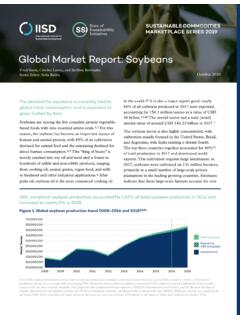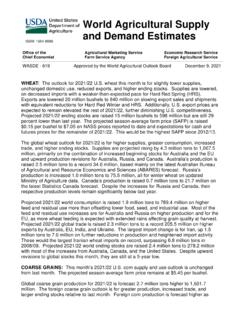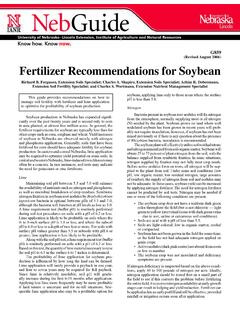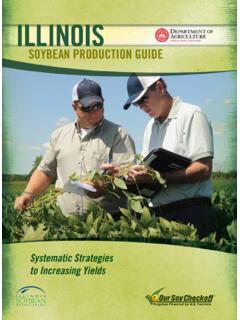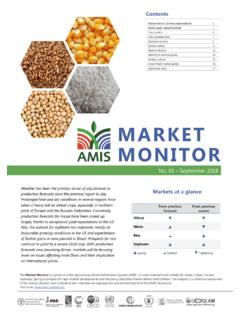Transcription of Department of Agronomy College of Agricultural and Life ...
1 A3654 WISCONSIN soybean Variety Performance Trials2021 Department of AgronomyCollege of Agricultural and Life SciencesUniversity of Wisconsin-MadisonPAGE 3A3654 2021 Wisconsin soybean Performance TrialsShawn P. Conley, Adam C. Roth, John M. Gaska, and Damon L. SmithDepartments of Agronomy and Plant PathologyUniversity of Wisconsin, Madisonplanting. This rapid planting window was followed by erratic precipitation patterns across most of the state through September, with the southeastern por-tion of WI experiencing the driest conditions. Cooler weather in late May led to frost damage in some areas. The 2021 projected statewide average soybean yield is bu/A, up bu/A from 2020. Produc-tion is expected to be at 112 million bushels, which is above the record crop of 2016. Source: October 12, 2021 NASS report, crop conditions were rated at about 73% good to excellent for most of the season.
2 As of October 31st, 84% of the WI soybean crop had been harvested, which is ahead of the 5-year average. Marshfield had some Phytophthora root rot inci-dence. Sudden death syndrome was found at the Seymour and Menomonie sites, but the severity was low. The Fond du Lac site was lost to a May 29th killing frost. Yields at the Hancock site were highly variable due to undetermined field performance was measuredYield: Plots were weighed and moisture was deter-mined in the field using electronic equipment on the plot harvester. Yields are reported in bushels (60 pounds/bushel) per acre at 13% moisture : Lodging scores were based on the aver-age erectness of the main stem of plants at maturity (1 = all plants erect, 2 = slight lodging, 3 = plants lodged at 45 degree angle, 4 = severe lodging, 5 = all plants flat).
3 Maturity: An entry was considered mature when at least 95% of the pods had turned their mature color. Seven to ten days of drying weather are gener-ally required before soybeans are ready to harvest. Variety performance is presented by brand, and then from earliest to latest based on the company supplied relative maturity of the and oilSeed samples from all varieties grown in select locations were collected and analyzed using a near infrared transmittance (NIRT) grain analyzer to determine grain composition. Our goal in providing this information is to increase soybean value trans-parency so producers can consider the protein and oil content of varieties planted as well as the yield. The factor that influences protein the most and that is under control of a producer is variety selection. Data from the Wisconsin soybean Variety Tests indi-cates that proper variety selection can result in 200 more pounds per acre of protein and oil without compromising grain Diseases of Wisconsin soybean Phytophthora Root Rot (caused by Phytopthora sojae)There are many races of P.
4 Sojae. Resistance genes are incorporated into varieties (see Table 10) to pro-vide complete or partial resistance to this organism The Wisconsin soybean Performance Trials are conducted each year with the producer s needs in mind. Our objective is to give pro-ducers the information to select varieties that will satisfy their specific goals and are most likely to perform best under their management the entries were testedSeed companies, private breeders and Univer-sity research and Extension specialists voluntarily submitted any number of entries they wished. Most of these entries are commercially available, but experimental varieties were also tested. Several additional commercial and public cultivars were included for were conducted using conventional, reduced tillage or no-till practices.
5 All performance trials were planted at 160,000 seeds/A, at row spacings listed in Table 1. Tests were conducted using a randomized complete block design with four repli-cates. Table 1 also lists the herbicides used for weed control in the conventional and glyphosate tolerant variety trials. The Janesville location was moved to Clinton for the 2021 conditionsWisconsin soybean growers experienced average growing conditions across much of the state in 2021. Below normal precipitation in April and May coupled with average temperatures expedited soybean PAGE 4as follows:Gene Races Rps1-a 1, 2, 10, 11, 13-18, 24 Rps1-b 1, 3-9, 13-15, 17, 18, 21, 22 Rps1-c 1-3, 6-11, 13, 15, 17, 21, 23, 24 Rps1-k 1-11, 13-15, 17, 18, 22, 24 Rps3-a 1-5, 8, 9, 11, 13, 14, 16, 18, 23, 25 Rps4 1-4, 10, 12, 16, 18-21, 25 Rps6 1-4, 10, 12, 14-16, 18-21, 25 Selection of soybean varieties with the appropriate resistance gene is paramount for its control.
6 Race 3 is the predominant form of Phytophthora in Wis-consin soils. Thus, the long-used Rps1-a gene is not providing protection 95% of the time. Race 4 occurs in 25% of Wisconsin soybean fields. Growers have an excellent chance of controlling race 3 by plant-ing varieties with the Rps1-c or Rps1-k gene. The Rps1-k gene provides complete resistance against most races of Phytophthora found in Wisconsin. That being said, race 25 has been found here in Wisconsin, and the Rps1-k gene does not protect against that race. Many varieties express tolerance (partial resistance) to all races of Phytophthora, but varieties with this form of resistance are vulnerable in the early seedling phase. Certain fungicides seed treatments can provide a window of protection to partially resistant varieties during emergence.
7 Variety resistance ratings are not reported and can be supplied by seed industry representatives. The information shown in Table 10 is based on informa-tion supplied by public breeders or companies that are releasing or marketing the variety. It is advised to consider Phytophthora resistance carefully as there was moderate incidence and severity of Phy-tophthora root and stem rot in Wisconsin in 2021. White Mold (caused by Sclerotinia sclerotiorum)The white mold fungus infects through the flow-ers during early reproductive growth; symptoms are delayed until early pod formation, and plant death is evident as the crop progresses towards maturity. White mold was a moderate issue in some fields in central and northeast Wisconsin in 2021. White mold in southern Wisconsin was sporadic and likely did not cause much yield reduction except on some very susceptible varieties.
8 The reaction of soybean varieties to the white mold pathogen is expressed as plant mortality in the presence of high white mold pressure and reduced grain yield when incidence is above 10%. Varieties that express 25% or less plant incidence generally yield well in the presence of white mold. However, for every 10% increase in white mold incidence at the R7 growth stage, one can expect yield to be reduced 2-5 bu/A. soybean Cyst Nematode (Heterodera glycines) soybean cyst nematode (SCN) has gained signifi-cant importance as a yield-limiting pathogen in Wisconsin. A major concern is that growers are not aware of its presence on their farms. SCN can cause severe stunting and chlorosis of soybean plants, but these symptoms are not always common; SCN can also cause major yield loss without obvious symptoms.
9 The most common symptom caused by SCN is a yield decline over years even though best crop management practices are used. Signifi-cant advances have been made to improve variet-ies for resistance to SCN. High yield performance in the presence of SCN is an excellent strategy to help select varieties that are resistant or tolerant in SCN infested fields. Watch for white mold when SCN resistant varieties are planted for the first time in SCN infested fields. SCN can suppress dense crop canopies required for white mold to develop. Many SCN resistant varieties are also resistant to brown stem rot. Free SCN soil testing for growers is avail-able through a grant from the Wisconsin soybean Marketing Board. For testing kits please email: For more informa-tion on SCN please visit: Stem Rot (caused by Cadophora gregata)Brown stem rot (BSR) is a major disease of soy-beans in Wisconsin.
10 In 2021, BSR was occasionally found in fields in Wisconsin. External symptoms of BSR are not observed until after pod development begins. There are examples where fields have both BSR and sudden death syndrome, which can make diagnoses difficult since foliar symptoms are similar. There are two pathotypes of the pathogen that cause BSR. The defoliating pathotype causes more severe internal stem discoloration and defoliation of leaves, compared with the non-defoliating pa-thotype that only causes internal stem symptoms. The non-defoliating pathotype may be becoming more prevalent, so be sure to cut soybean stems to identify symptoms if you notice plants that are unthrifty, stunted, or yellowing prematurely. Select resistant varieties if BSR has been a problem in the field. Some SCN-resistant soybean varieties are also resistant to BSR.


